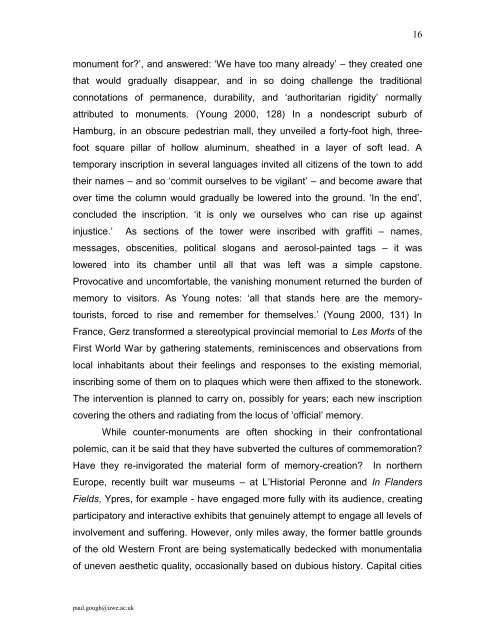Gough, P. (2008) Commemoration of war. In: Graham, B. and ...
Gough, P. (2008) Commemoration of war. In: Graham, B. and ...
Gough, P. (2008) Commemoration of war. In: Graham, B. and ...
Create successful ePaper yourself
Turn your PDF publications into a flip-book with our unique Google optimized e-Paper software.
monument for?‟, <strong>and</strong> answered: „We have too many already‟ – they created one<br />
that would gradually disappear, <strong>and</strong> in so doing challenge the traditional<br />
connotations <strong>of</strong> permanence, durability, <strong>and</strong> „authoritarian rigidity‟ normally<br />
attributed to monuments. (Young 2000, 128) <strong>In</strong> a nondescript suburb <strong>of</strong><br />
Hamburg, in an obscure pedestrian mall, they unveiled a forty-foot high, three-<br />
foot square pillar <strong>of</strong> hollow aluminum, sheathed in a layer <strong>of</strong> s<strong>of</strong>t lead. A<br />
temporary inscription in several languages invited all citizens <strong>of</strong> the town to add<br />
their names – <strong>and</strong> so „commit ourselves to be vigilant‟ – <strong>and</strong> become a<strong>war</strong>e that<br />
over time the column would gradually be lowered into the ground. „<strong>In</strong> the end‟,<br />
concluded the inscription. „it is only we ourselves who can rise up against<br />
injustice.‟ As sections <strong>of</strong> the tower were inscribed with graffiti – names,<br />
messages, obscenities, political slogans <strong>and</strong> aerosol-painted tags – it was<br />
lowered into its chamber until all that was left was a simple capstone.<br />
Provocative <strong>and</strong> uncomfortable, the vanishing monument returned the burden <strong>of</strong><br />
memory to visitors. As Young notes: „all that st<strong>and</strong>s here are the memory-<br />
tourists, forced to rise <strong>and</strong> remember for themselves.‟ (Young 2000, 131) <strong>In</strong><br />
France, Gerz transformed a stereotypical provincial memorial to Les Morts <strong>of</strong> the<br />
First World War by gathering statements, reminiscences <strong>and</strong> observations from<br />
local inhabitants about their feelings <strong>and</strong> responses to the existing memorial,<br />
inscribing some <strong>of</strong> them on to plaques which were then affixed to the stonework.<br />
The intervention is planned to carry on, possibly for years; each new inscription<br />
covering the others <strong>and</strong> radiating from the locus <strong>of</strong> „<strong>of</strong>ficial‟ memory.<br />
While counter-monuments are <strong>of</strong>ten shocking in their confrontational<br />
polemic, can it be said that they have subverted the cultures <strong>of</strong> commemoration?<br />
Have they re-invigorated the material form <strong>of</strong> memory-creation? <strong>In</strong> northern<br />
Europe, recently built <strong>war</strong> museums – at L‟Historial Peronne <strong>and</strong> <strong>In</strong> Fl<strong>and</strong>ers<br />
Fields, Ypres, for example - have engaged more fully with its audience, creating<br />
participatory <strong>and</strong> interactive exhibits that genuinely attempt to engage all levels <strong>of</strong><br />
involvement <strong>and</strong> suffering. However, only miles away, the former battle grounds<br />
<strong>of</strong> the old Western Front are being systematically bedecked with monumentalia<br />
<strong>of</strong> uneven aesthetic quality, occasionally based on dubious history. Capital cities<br />
paul.gough@uwe.ac.uk<br />
16
















